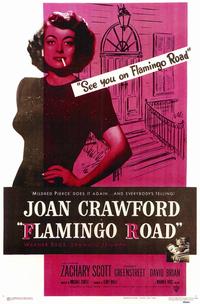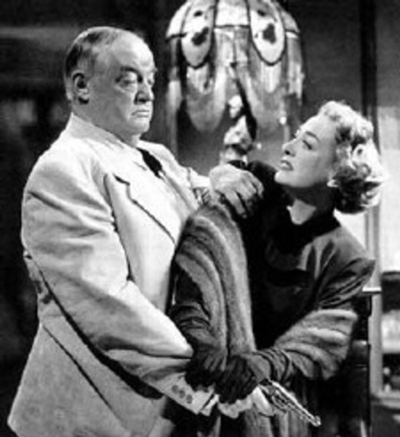By Michael Wilmington and Film Noir Blonde
The Noir File is FNB’s weekly guide to classic film noir, neo-noir and pre-noir on cable TV. All the movies below are from the current schedule of Turner Classic Movies (TCM), which broadcasts them uncut and uninterrupted. The times are Eastern Standard and (Pacific Standard).
“Flamingo Road” (1949, Michael Curtiz) Friday, Oct. 19, 11:45 p.m. (8:45 p.m.)
Joan Crawford is at her dark-eyed, femme fatale peak in this spicy, fast-moving saga from director Michael Curtiz (“Casablanca”). Co-scripted by Robert Wilder, based on his best-selling novel and play. Joan has one of her archetypal roles: a tough carnival dancer left stranded in a crooked Southern city, who rises to the top while juggling the hearts of both the local deputy sheriff turned gubernatorial front-runner (Zachary Scott) and a high-flying wheeler-dealer (David Brian). She also must evade the venomous hatred and harassments of the tyrannical local political boss (Sydney Greenstreet, at his slimiest, flapping a fan on his porch, casting baleful glances and cooking up dark schemes).
Decades later, “Flamingo Road” became a hit TV series (1980-2). This movie was a success in its time too. It’s also one of Crawford’s top mid-career vehicles, along with “Mildred Pierce,” “Possessed” and “Johnny Guitar.” Here, she’s a streetwise, bedroom-savvy beauty battling corruption and prejudice in the kind of Deep South town where old boys call the shots, but where shady ladies can bring them down, and where violence simmers under a high-toned veneer.
Curtiz’s “Flamingo Road” was also one of the all-time favorite movies of German art film giant R. W. Fassbinder (“The Marriage of Maria Braun”). Fassbinder, a ’70s noir specialist and a strong Curtiz admirer, named “Flamingo Road” No. 2 on his all-time top 10 best films list, right behind his top choice, Luchino Visconti’s “The Damned.” They’re both classics, but, as for femme fatales, we’ll take Curtiz’s Joan Crawford over Visconti’s Helmut Berger any day.
Sunday, Oct. 21
5 a.m. (2 a.m.): “Bullets for O’Hara” (1941, William K. Howard). Neat little B-movie from the director of “The Power and the Glory,” with mobster Anthony Quinn targeted by both the FBI and wife Joan Perry.
Monday, Oct. 22
3:15 p.m. (12:15 p.m.): “The Bigamist” (1953, Ida Lupino). Director/star Ida Lupino whips up a potent brew of soap and noir, with this nervous tale of bigamist Edmond O’Brien shuttling between unknowing wives Lupino and Joan Fontaine.
4:45 p.m. (1:45 p.m.): “Beyond a Reasonable Doubt” (1956, Fritz Lang). Dana Andrews, one of film noir’s acting icons, plays a crusading writer who decides to test the protection of reasonable doubt against the trial system and capital punishment. One of noir master Fritz Lang’s last American films and another of his anti-capital punishment stories, but with an unusual twist. Some of Lang’s ’50s French admirers on the magazine “Cahiers du Cinema,” like Jacques Rivette, thought particularly highly of this film. Co-starring Joan Fontaine, Sidney Blackmer and Edward Binns.
Wednesday, Oct. 24
8:45 a.m. (5:45 a.m.): “The Letter” (1940, William Wyler). The one and only Bette Davis as a treacherous, murderous and unrepentant (natch) femme fatale. Based on the Somerset Maugham novel; co-starring Herbert Marshall and James Stephenson.
9:45 p.m. (6:45 p.m.): “Murders in the Rue Morgue” (1932, Robert Florey). A stylish and horrific movie version of one of Edgar Allan Poe’s classic mystery stories, done with all the German expressionist trimmings director Robert Florey (“The Beast with Five Fingers”) can muster. Also: Grand hamming by star Bela Lugosi as the evil Dr. Mirakle, supported by Sidney Fox, Arlene Francis and Leon Ames (as Poe’s detective Dupin). Co-scripted by John Huston.












From FNB readers